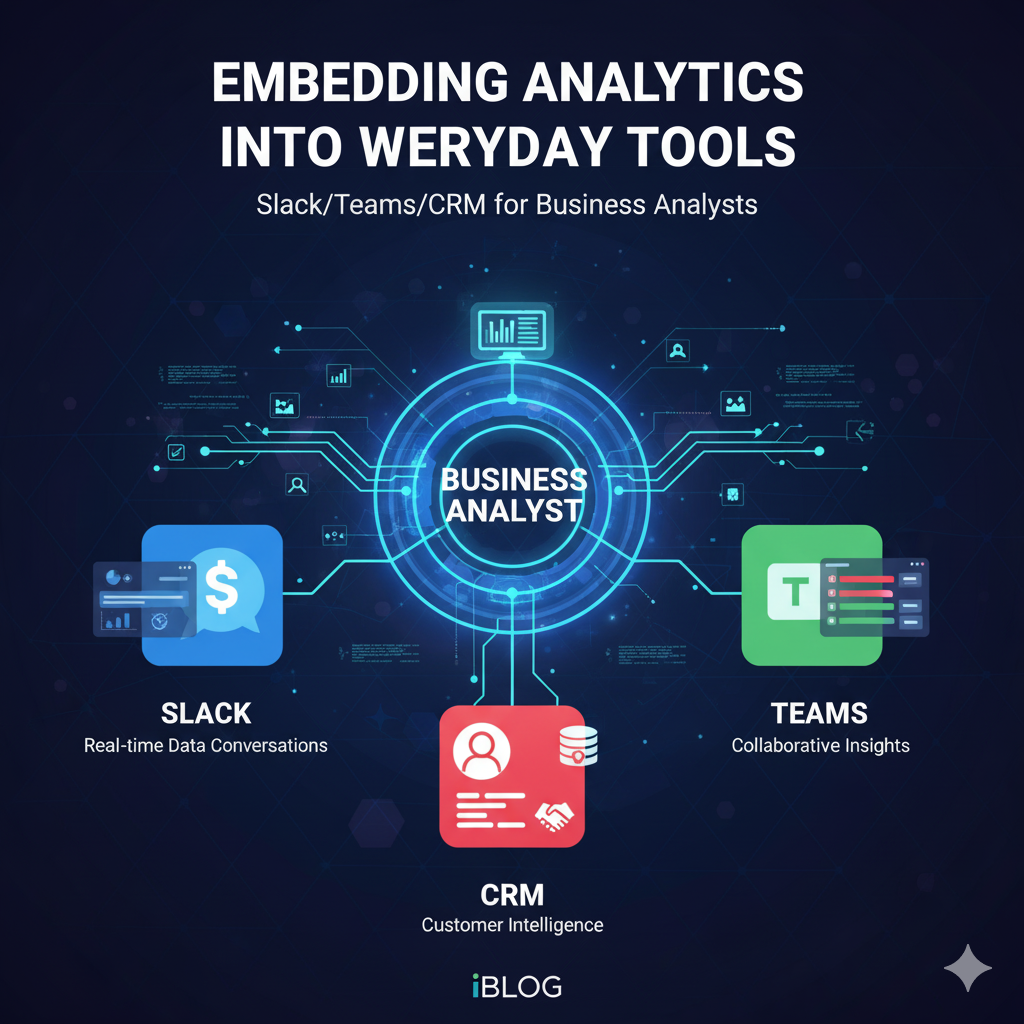
Embedding Analytics into Everyday Tools (Slack/Teams/CRM) for Business Analysts
In 2025, data isn’t just collected—it lives inside the tools you use every day. For business analysts and decision-makers, the biggest transformation is no longer “go to BI dashboards” but rather “insights come to me”. Embedding analytics into everyday tools like Slack, Microsoft Teams, and CRM systems changes the game: insights appear in the moment of decision, not hours later.
If you’re a business analyst, project manager, or operations lead, you need to understand how analytics embedded into your workflow becomes your competitive edge. Here’s how to make it work—and why it matters.
What Is Embedded Analytics?
Embedded analytics (also called embedded BI) refers to integrating analytics capabilities—reports, dashboards, visualizations, predictive models—directly into business applications or platforms employees already use. TechTarget+2cube.dev+2
Rather than switching to a separate analytics tool, users stay within their workflow (Slack thread, Teams channel, CRM screen) and receive insights contextually and immediately. For example: a sales rep in a CRM sees a forecast and churn score without leaving the deal view; an operations manager using Teams receives an alert with manufacturing uptime stats and a drill-down right there.
According to TechTarget, embedded analytics “allows data analysis and visualization functionality to be part of the software users perform tasks in” eliminating workflow interruption. TechTarget+1
This is the foundation. Now let’s explore why embedding analytics into everyday tools is essential in 2025.
Why Embedding Analytics into Everyday Tools Matters in 2025
1. Real-Time Decision Making
Business moves faster than ever. Traditional Analytics required switching apps, waiting for dashboards, then making decisions. Embedded analytics turns that lag into real-time insight: you get context, pattern, and recommendation in the tool you already use. As one article puts it: “Analytics in the decision point.” Technology Magazine+1
2. Better User Adoption & Productivity
One of the main barriers to analytics adoption is the friction of learning new tools, logging in, exporting data. Embedded analytics removes that friction—users don’t leave their environment. This leads to higher adoption, more frequent usage, and ultimately better decisions. TechTarget+2explo.co+2
3. Contextual & Relevant Insights
When insights are embedded, they are contextual—they appear at the moment and place where decisions happen (e.g., a CRM deal page or a chat in Slack). Context means higher relevance, faster reaction, less noise. APSense+1
4. Democratization of Analytics
Rather than analytics being siloed in a BI team and delivered as periodic reports, embedding brings analytics into everyone’s hands—sales, marketing, HR, ops. This democratizes data-driven decision making. Technology Magazine
5. Competitive Advantage in Hybrid Work Environments
With distributed teams using collaboration tools such as Teams and Slack, embedding analytics here means the entire workforce has access to insights wherever they are. As remote/hybrid work becomes permanent, this capability is a key differentiator.
Everyday Tools Where Embedding Analytics Makes a Difference 📥 Collaboration & Chat Tools: Slack / Microsoft Teams
Imagine this: you’re in Slack discussing project KPIs, and a bot posts: “Project X’s risk score just jumped to 72 % based on last 24h commits & delays.” You click the link and instantly drill into a dashboard inside Slack. No switching to a BI platform.
In Teams, you can embed live dashboards in a channel tab. A business analyst can pin the weekly forecast inside the “Sales Ops” team channel so that the whole regional team sees updated data every time they open the chat.
These integrations mean business analysts, managers and project leads get insights where they communicate — making analytics part of collaboration.
💼 CRM Systems (Salesforce, Dynamics 365, HubSpot)
For sales and customer-facing teams, embedding analytics inside the CRM is critical. Instead of exporting to Excel, a sales rep sees: likelihood to close, next best action, churn risk, upsell opportunity—all inside the opportunity record.
According to NetSuite, embedded analytics in a CRM “improve your understanding of business context and discover actionable insights … in the unified platform.” NetSuite
For analysts, this means you can deliver value directly inside applications the business already uses—boosting impact and visibility.
🛠️ Project Management & Workflow Platforms (Asana, Jira, Monday.com)
Business analysts working in operations, IT, or PMO functions often use tools like Jira or Asana. Embedding dashboards here—showing sprint velocity, backlog health, risk heatmaps—means stakeholders don’t need to leave the tool to get data. Analysts can set up visual cards inside the workflow board, pulling from real data sources in real time.
📊 Custom Analytics Widgets in Reports and Tools
Beyond the big platforms, embedding analytics into internal portals, dashboards, or even in chatbots is becoming standard. According to a blog on Explo, by 2025 embedded analytics will deliver value by launching inside existing workflows with minimal disruption. explo.co
Business Analyst Perspective: How to Make It Work
As a Business Analyst (BA), your role evolves from report provider to insight enabler. Embedding analytics inside everyday tools means you must:
Step 1: Identify High-Impact Use Cases
Pick contexts where decisions are made and embed analytics there. Examples:
-
Sales rep CRM screen: Embedded analytics to show “deal at risk”, “upsell chance”, “next action”.
-
Slack channel for Ops: Real-time alert + dashboard on equipment performance or customer support metrics.
-
Project board in Jira: Risk/issue heatmap embedded in the board view.
Focus first on decisions that are time-sensitive, involve multiple stakeholders, and rely on data.
Step 2: Work With Tool Integrations
Investigate how your tool supports embedding. Does Slack support apps or bots? Does Teams allow tabs or Power BI embedding? Does the CRM support widgets/Dashboards?
Many BI platforms (Power BI, Tableau, Sisense) now support embedding via APIs or SDKs. Querio+1
Step 3: Design the Analytics to Serve the Workflow
Embedded analytics should be contextual, lightweight, and actionable. Consider:
-
Display key metrics on the primary screen.
-
Provide alert or notification when a KPI breaches a threshold.
-
Allow drill-down from the embedded view into detailed dashboards if needed.
-
Ensure visualization works inside the embedded environment (mobile friendly, minimal switching).
This way, you minimise friction and deliver insights when they matter.
Step 4: Data & Model Preparation
Your analytics behind the scenes should be robust:
-
Ensure data quality and governance.
-
Make models (predictive, risk scores, trending) accessible via the embedded tool.
-
Automate refresh and ensure real-time or near-real-time data feeding.
Embedded analytics doesn’t help if the data is stale. As noted, “analytics should become a regular part of how people work”. SAS
Step 5: Measure Impact & Iterate
Track adoption (how often are embedded widgets used?), decision acceleration, outcome improvement (reduced churn, faster project delivery, fewer delays). Use these metrics to refine your embedding strategy and expand to additional tools or teams.
Real-Life Case Studies
🔹 Case Study 1: Sales Team Using Embedded Analytics in CRM
A global software company integrated a predictive upsell and churn model directly into their sales CRM dashboard. Sales reps working in the CRM saw an embedded card: “This account has a 45 % churn risk in next 30 days. Top upsell product: X.”
As a result:
-
Upsell conversions increased by 18 %.
-
Churn in targeted accounts dropped by 12 %.
Because the insight was right in their workflow, the rep acted immediately.
🔹 Case Study 2: Operations Team Using Slack & Embedded Analytics
A manufacturing firm set up a dedicated Slack channel for machine-status alerts. When a key production machine’s vibration metrics exceeded thresholds, a Slack bot posted with an embedded mini-dashboard inside the channel. The operations analyst clicked through to a deeper dashboard embedded in their internal portal.
The result:
-
Downtime events decreased by 25 %.
-
Maintenance interventions became proactive rather than reactive.
This shows how collaboration tools + analytics reduce latency in decision-making.
🔹 Case Study 3: Project Delivery & Embedded Analytics in Teams
An IT services company embedded dashboards within Microsoft Teams channels for each project. The embedded view showed sprint health, issue backlog, team load, and projected over-run risk. Because executives, project managers and analysts all saw the same view inside Teams, escalation happened earlier.
Outcomes:
-
Project-overrun incidents dropped by 20 %.
-
Stakeholder satisfaction increased as metrics were visible and shared in the live collaboration tool.
Challenges & Considerations for 2025
While embedding analytics is highly beneficial, it comes with considerations:
🔸 Security & Access Control
When analytics are embedded into collaboration tools or CRM systems, you must ensure role-based access, data privacy, multi-tenant isolation (if applicable) and compliance with regulations such as GDPR or India’s DPDP. NetSuite+1
🔸 Integration & Data Quality
Content is only as good as the underlying data. Bridging multiple systems, ensuring data freshness, handling streaming data, and managing ETL/ELT pipelines are still complex tasks. Embedded analytics cannot offset poor data. TechTarget
🔸 User Experience & Workflow Fit
Embedding analytics into tools doesn’t guarantee adoption—if the embedded view is clumsy, slow, or irrelevant, users won’t use it. The key is making analytics invisible (i.e., integrated seamlessly) and actionable. explo.co
🔸 Analytics Model Maintenance
If you embed predictive models, they must be maintained, retrained, and monitored for bias, drift, accuracy. Otherwise, you risk providing misleading insights. The operationalisation of analytics, rather than just developing models, is critical. SAS
The Future of Embedded Analytics for Business Analysts
By 2025 and beyond, emerging trends are shaping the evolution of embedded analytics:
-
Conversational & Chatbot Analytics: Embedded analytics accessible via natural-language chat in Slack/Teams (e.g., “What’s the forecast for Region A next quarter?”).
-
AI-Driven Prescriptive Insights: Moving beyond “what happened” to “what should we do” within the app. Publications note embedded analytics now enabling prescriptive capabilities. Technology Magazine
-
Edge & Real-Time Data Workflows: With analytics embedded in collaboration apps, real-time streaming and event-based triggers will become more common.
-
Citizen Data Analysts in Everyday Tools: Platforms will allow non-technical analysts to build embedded views inside Slack/Teams without coding, increasing democratization. Technology Magazine
-
Hybrid Analytics Architecture: While embedding, analytics systems will integrate with cloud, edge and on-premises architectures to support enterprise scale and governance.
Key Takeaways for Business Analysts
-
Embedding analytics into everyday tools (Slack/Teams/CRM) changes your role: from analyst and report-writer to workflow embedded insight enabler.
-
Prioritise high-impact use cases where decision-making happens inside existing tools.
-
Ensure analytics are contextual, timely, actionable and within the user’s tool of choice.
-
Focus on data quality, model maintenance, integration, governance and UI/UX to make embedded analytics effective.
-
Measure adoption and business outcomes—not just dashboards built—to gauge success and scale accordingly.
-
Stay ahead of trends: conversational analytics, AI-driven prescriptive insights, citizen-analytics and hybrid architectures will define the next frontier.
-
Check out our training programs to upskill: our Data Analytics & AI Courses and Business Analysis Courses at ChronoLearn will teach you the tools and strategy to embed analytics inside your tools and workflows.
Final Thoughts
In 2025, the separation between data tools and business tools is dissolving. For business analysts, embedding analytics into everyday tools like Slack, Teams, and CRM isn’t just “nice to have”—it’s becoming essential for driving faster, smarter decisions.
Whether you’re working on sales insights, operations risk, project delivery metrics or customer support KPIs—the ability to place analytics in context, in workflow, and at decision point will determine competitiveness and impact.
If you’re ready to move beyond standalone dashboards and make analytics part of the conversation your teams have every day—start embedding. Dive into our Analytics & AI training at ChronoLearn and empower your organization to act, not just analyse.






